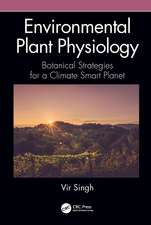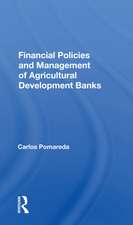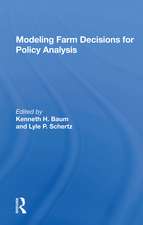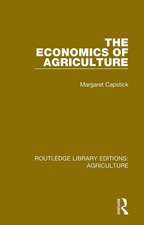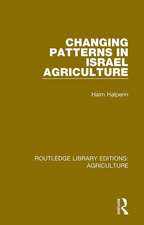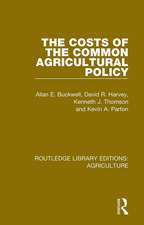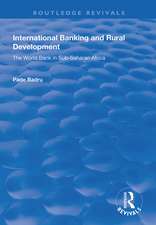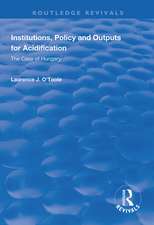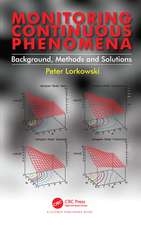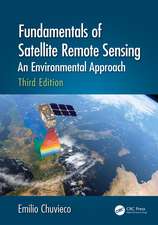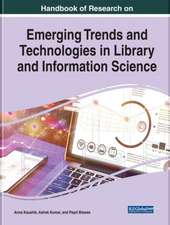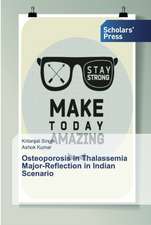Microbes and Enzymes in Soil Health and Bioremediation: Microorganisms for Sustainability, cartea 16
Editat de Ashok Kumar, Swati Sharmaen Limba Engleză Paperback – 21 ian 2021
The microbiological component of the soil is ahighly complex system and is still not fully understood. How do microbes survive in the changing physicochemical environment of soil?. This book helps readers understand the mechanism, various routes of microbialsoil remediation, the interactionsof different genera, and how microbial enzymes support the sustainable restoration of healthy soil.
| Toate formatele și edițiile | Preț | Express |
|---|---|---|
| Paperback (1) | 793.30 lei 39-44 zile | |
| Springer Nature Singapore – 21 ian 2021 | 793.30 lei 39-44 zile | |
| Hardback (1) | 809.21 lei 39-44 zile | |
| Springer Nature Singapore – 3 dec 2019 | 809.21 lei 39-44 zile |
Din seria Microorganisms for Sustainability
- 24%
 Preț: 794.72 lei
Preț: 794.72 lei - 18%
 Preț: 933.27 lei
Preț: 933.27 lei - 24%
 Preț: 1033.06 lei
Preț: 1033.06 lei - 24%
 Preț: 967.12 lei
Preț: 967.12 lei - 18%
 Preț: 1194.90 lei
Preț: 1194.90 lei - 24%
 Preț: 1196.29 lei
Preț: 1196.29 lei - 24%
 Preț: 1193.04 lei
Preț: 1193.04 lei - 18%
 Preț: 1204.16 lei
Preț: 1204.16 lei - 18%
 Preț: 1095.95 lei
Preț: 1095.95 lei - 18%
 Preț: 930.48 lei
Preț: 930.48 lei - 18%
 Preț: 1204.16 lei
Preț: 1204.16 lei - 24%
 Preț: 834.63 lei
Preț: 834.63 lei - 18%
 Preț: 1364.70 lei
Preț: 1364.70 lei - 18%
 Preț: 1095.17 lei
Preț: 1095.17 lei - 18%
 Preț: 984.62 lei
Preț: 984.62 lei - 24%
 Preț: 808.32 lei
Preț: 808.32 lei - 15%
 Preț: 637.21 lei
Preț: 637.21 lei - 18%
 Preț: 929.39 lei
Preț: 929.39 lei - 18%
 Preț: 931.86 lei
Preț: 931.86 lei - 15%
 Preț: 630.46 lei
Preț: 630.46 lei - 18%
 Preț: 928.46 lei
Preț: 928.46 lei - 18%
 Preț: 928.16 lei
Preț: 928.16 lei - 18%
 Preț: 1355.72 lei
Preț: 1355.72 lei - 24%
 Preț: 783.41 lei
Preț: 783.41 lei - 18%
 Preț: 929.55 lei
Preț: 929.55 lei - 24%
 Preț: 1052.02 lei
Preț: 1052.02 lei - 18%
 Preț: 1202.76 lei
Preț: 1202.76 lei
Preț: 793.30 lei
Preț vechi: 1043.82 lei
-24% Nou
Puncte Express: 1190
Preț estimativ în valută:
151.85€ • 159.22$ • 125.46£
151.85€ • 159.22$ • 125.46£
Carte tipărită la comandă
Livrare economică 27 ianuarie-01 februarie 25
Preluare comenzi: 021 569.72.76
Specificații
ISBN-13: 9789811391194
ISBN-10: 981139119X
Pagini: 401
Ilustrații: XII, 401 p. 67 illus., 41 illus. in color.
Dimensiuni: 155 x 235 mm
Ediția:1st ed. 2019
Editura: Springer Nature Singapore
Colecția Springer
Seria Microorganisms for Sustainability
Locul publicării:Singapore, Singapore
ISBN-10: 981139119X
Pagini: 401
Ilustrații: XII, 401 p. 67 illus., 41 illus. in color.
Dimensiuni: 155 x 235 mm
Ediția:1st ed. 2019
Editura: Springer Nature Singapore
Colecția Springer
Seria Microorganisms for Sustainability
Locul publicării:Singapore, Singapore
Cuprins
Chapter 1. Let’s protect our earth: Environmental challenges and implications.- Chapter 2. Microbes and Processes in Bioremediation of Soil.- Chapter 3. Unique microorganisms inhabit natural extreme soils.- Chapter 4. Effect of Pollution on Physical & Chemical Properties of Soil.- Chapter 5. Role of soil microbiome and enzyme activities in plant growth nutrition and ecological restoration of soil health.- Chapter 6. Marine microbes in Bioremediation: Current status and future trends.- Chapter 7. Role of Microbial Hydrolases in Bioremediation.- Chapter 8. Laccases for soil bioremediation.- Chapter 9. Environmental fate of organophosphate residues from agricultural soils to fresh farm produce: Microbial interventions for sustainable bioremediation strategies.- Chapter 10. Secreted Microbial Enzymes for Organic Compound Degradation.- Chapter 11. Role of microbes in degradation of chemical pesticides.- Chapter 12. Biodegradation of Pesticides in Brazil and other Tropical Countries: Experimental and in silico Studies.- Chapter 13. Microbial Degradation of Phenolic Compounds.
Notă biografică
Dr. Ashok Kumar is an Assistant Professor at the Department of Biotechnology and Bioinformatics, Jaypee University of Information Technology, India. He completed his Ph.D. in Biotechnology at the Department of Biotechnology, Himachal Pradesh University, India, and worked as a postdoctoral fellow at the State Key Laboratory of Agricultural Microbiology, Huazhong Agricultural University, China. He also worked as a Brain Pool researcher/Assistant Professor at Department of Chemical Engineering Konkuk University Seoul South Korea.. Dr. Ashok has a keen interest in enzyme immobilization, biomaterials, biopolymers, nanobiotechnology, biocatalysis, waste management, biomass degradation, biofuel synthesis, and biotransformation. He has published 47 research papers in various internationally respected journals, 1 book, and 15 book chapters.
Dr. Swati Sharma completed her Ph.D. from Department of Chemical and Natural Resources Engineering Universiti Malaysia Pahang , Malaysia. She worked as a Visiting Researcher at the College of Life and Environmental Sciences at Konkuk University, South Korea. Dr. Sharma has completed her masters (M.Sc.) at the Dr. Yashwant Singh Parmar University of Horticulture and Forestry, India, and she also worked as a Program Co-coordinator at the Himalayan Action Research Center, Dehradoon and Senior Research Fellow at the India Agricultural Research Institute. Dr. Sharma's current research is in the field of bioplastics, hydrogels, keratin nano-fibers and nanoparticles, biodegradable polymers and polymers with antioxidant and anti-cancerous activities and sponges. Dr. Swati has published 16 research papers in various respected international journals, 1 book, and a number of book chapters.
Dr. Swati Sharma completed her Ph.D. from Department of Chemical and Natural Resources Engineering Universiti Malaysia Pahang , Malaysia. She worked as a Visiting Researcher at the College of Life and Environmental Sciences at Konkuk University, South Korea. Dr. Sharma has completed her masters (M.Sc.) at the Dr. Yashwant Singh Parmar University of Horticulture and Forestry, India, and she also worked as a Program Co-coordinator at the Himalayan Action Research Center, Dehradoon and Senior Research Fellow at the India Agricultural Research Institute. Dr. Sharma's current research is in the field of bioplastics, hydrogels, keratin nano-fibers and nanoparticles, biodegradable polymers and polymers with antioxidant and anti-cancerous activities and sponges. Dr. Swati has published 16 research papers in various respected international journals, 1 book, and a number of book chapters.
Textul de pe ultima copertă
Microbial enzymes play a vital role in maintaining soil health and removing pollutants from contaminated land. Soil microflora is closely associated with maintaining soil fertility, and the use of chemical pesticides, fertilizers and other volatile sprays in agriculture threatens the health ofthe microbial population in the soil. Every single particle of healthy soil contains millions of bacteria, which interact with the nutrients available, sustaining the nutrient cycle and making this microflora an essential component of life on earth. How do microbes help in the nutrient cycle? Either by intracellular digestion of macromolecules and converting these into smaller units in their metabolic pathways, or by secreting enzymes into the extracellular environment to facilitate the conversion of complex macromolecules into micro-molecules that can be easily absorbed by other living species. To meet demands for energy and food for the growing global population, it is important to protect agricultural land from contamination and maintain its productivity. Heavy metal ions from contaminated land canenter crops, fish or aquatic organismsvia contaminated water, and theseare then taken up by the human body, where they can accumulate and alter the normal microflora.
The microbiological component of the soil is ahighly complex system and is still not fully understood. How do microbes survive in the changing physicochemical environment of soil?. This book helps readers understand the mechanism, various routes of microbialsoil remediation, the interactionsof different genera, and how microbial enzymes support the sustainable restoration of healthy soil.
The microbiological component of the soil is ahighly complex system and is still not fully understood. How do microbes survive in the changing physicochemical environment of soil?. This book helps readers understand the mechanism, various routes of microbialsoil remediation, the interactionsof different genera, and how microbial enzymes support the sustainable restoration of healthy soil.
Caracteristici
Presents the mechanism and various routes of bioremediation in the soil by microbes and their interaction with different genera Provides details of microbes and their enzymes which are involved in various remediation pathways Explains the bioremediation process of harmful chemical by single bacteria, enzymes or complex microbial communities

